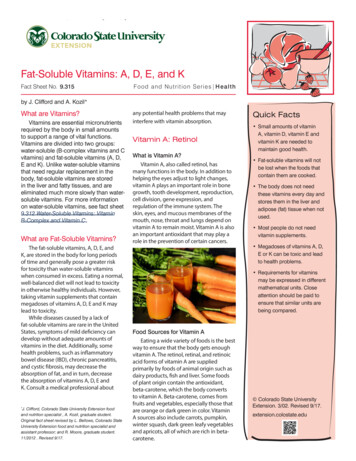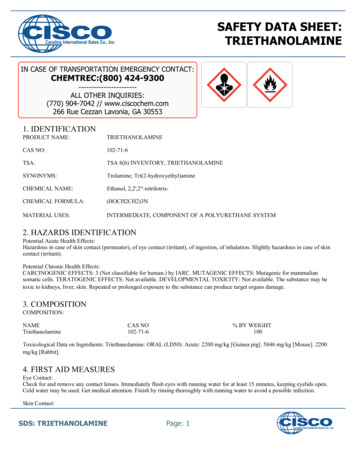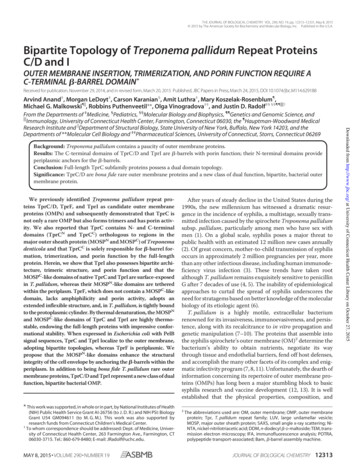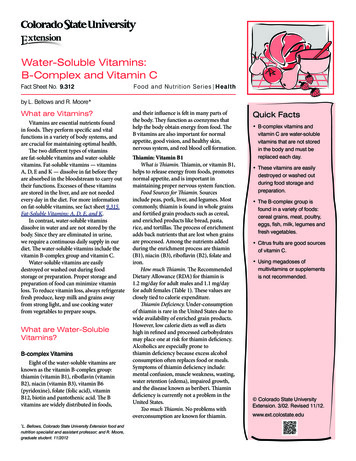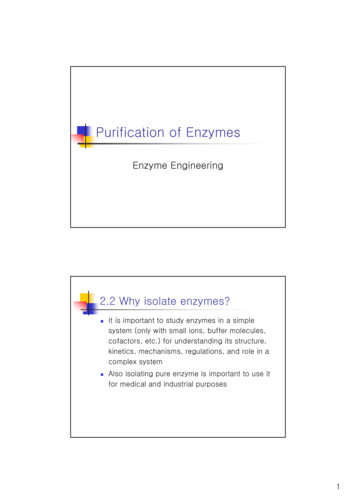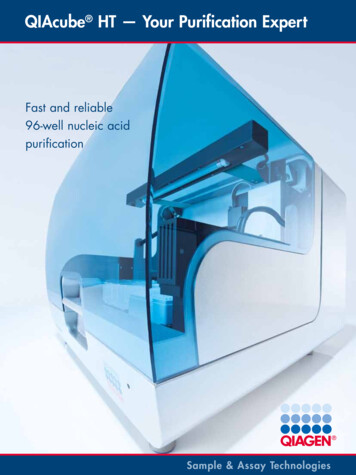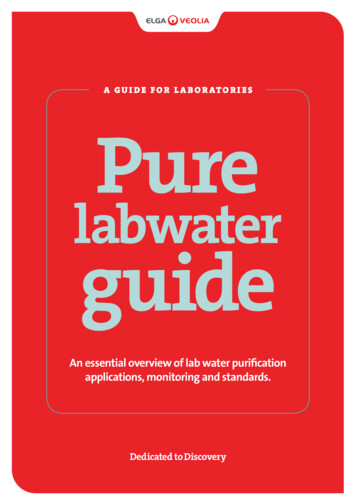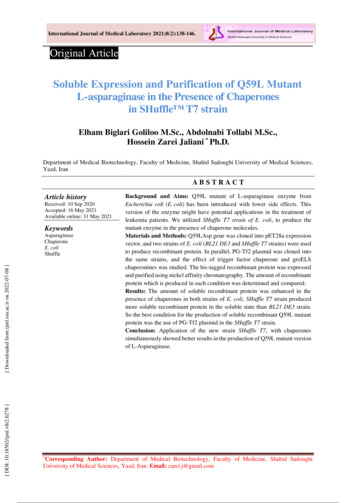
Transcription
International Journal of Medical Laboratory 2021;8(2):138-146.Original ArticleSoluble Expression and Purification of Q59L MutantL-asparaginase in the Presence of Chaperonesin SHuffle T7 strainElham Biglari Goliloo M.Sc., Abdolnabi Tollabi M.Sc.,Hossein Zarei Jaliani * Ph.D.Department of Medical Biotechnology, Faculty of Medicine, Shahid Sadoughi University of Medical Sciences,Yazd, IranABSTRACTArticle historyReceived: 10 Sep 2020Accepted: 16 May 2021Available online: 31 May 2021Keywords[ DOI: 10.18502/ijml.v8i2.6278 ][ Downloaded from ijml.ssu.ac.ir on 2022-07-08 ]AsparaginaseChaperoneE. coliShuffle*Background and Aims: Q59L mutant of L-asparaginase enzyme fromEscherichia coli (E. coli) has been introduced with lower side effects. Thisversion of the enzyme might have potential applications in the treatment ofleukemia patients. We utilized SHuffle T7 strain of E. coli, to produce themutant enzyme in the presence of chaperone molecules.Materials and Methods: Q59LAsp gene was cloned into pET28a expressionvector, and two strains of E. coli (BL21 DE3 and SHuffle T7 strains) were usedto produce recombinant protein. In parallel, PG-Tf2 plasmid was cloned intothe same strains, and the effect of trigger factor chaperone and groELSchaperonines was studied. The his-tagged recombinant protein was expressedand purified using nickel affinity chromatography. The amount of recombinantprotein which is produced in each condition was determined and compared.Results: The amount of soluble recombinant protein was enhanced in thepresence of chaperones in both strains of E. coli. SHuffle T7 strain producedmore soluble recombinant protein in the soluble state than BL21 DE3 strain.So the best condition for the production of soluble recombinant Q59L mutantprotein was the use of PG-Tf2 plasmid in the SHuffle T7 strain.Conclusion: Application of the new strain SHuffle T7, with chaperonessimultaneously showed better results in the production of Q59L mutant versionof L-Asparaginase.Corresponding Author: Department of Medical Biotechnology, Faculty of Medicine, Shahid SadoughiUniversity of Medical Sciences, Yazd, Iran. Email: zarei.j@gmail.com
E. Biglari Goliloo et al.[ DOI: 10.18502/ijml.v8i2.6278 ][ Downloaded from ijml.ssu.ac.ir on 2022-07-08 ]IntroductionL-Asparaginase (ASNase) is widely consideredwith the most commonly encountered problemthe most important biopharmaceutical usedbeing the aggregation of recombinant proteinsin the treatment of various types of leukemia,[13, 14]. Factors that are related to protein foldingespecially acute lymphoblastic leukemia andin E. coli have been separated from the cytoplasmlymphosarcoma [1, 2]. This enzyme catalyzes theof the bacteria, which is the main site ofconversion of L-asparagine (Asn) to L-aspartaterecombinant(Asp) and ammonia (NH2), leading to asparagineenhancing the efficiency of recombinant proteindeficiency, inhibiting the synthesis of DNA,synthesis in the correct structure and low cost inRNA, and proteins, and consequently the growthE. coli has remained a challenging issue yet [15].of cancer cells [3, 4]. To date, various iso-Many advances have been conducted in the fieldenzymes have been recognized in a wide varietyof strain engineering in the last decades forof organisms, including bacteria, yeasts, andrecombinant protein production in E. coli.higher eukaryotes [2, 5, 6]. Isolated iso-enzymesRecombinant protein synthesis, degradation,of microorganisms, especially bacteria, have beensecretion, or folding could be improved by hostshown to be more effective [7]. Despite beingstrain engineering [16]. Various problems andan extensively used drug, ASNase displays aissues involved in the protein production in E. colisecondary L-glutaminase activity [8]. Thisare also pursued in the engineering of E. colinon-specific activity of the enzyme producesstrains, including engineering of mRNA stabilityside effects such as immunological reactions,and translational efficiency, improving proteinpancreatitis,coagulationfolding by chaperone coexpression, expression ofabnormalities, etc., it is necessary to identify thedisulfide-bonded proteins, production of acetylatediso-enzymes with fewer complications [9].protein and glycoproteins in E. coli [16, 17].CommercialtheseIn recent years, efforts have been made to increasebiotherapeutics are Escherichia coli (E. coli) andthe solubility of a recombinant protein and reduceErwinia Chrysanthemi that have long beenthe amount of protein deposited in the cell duringapproved in the United States and Europe [2, 10].production to achieve a properly folded structure,Several research studies have been conductedsuch as modification in the rate of proteinon the production of this enzyme by usingsynthesis, using fusion proteins, mutagenesis inrecombinant DNA technology [11]. Due tothe target protein, and coexpression withthe lack of post-translational modifications inmolecular chaperones [13]. These engineeredASNase protein molecule, E. coli can be a simplestrains include ClearColi , SHuffle and etc, inand popular host for the production ofwhich the genetically engineered SHuffle cellsrecombinant ASNase protein [12]. In general,resolved the problem of solubility and properthere are many possible problems for thedisulfide bond formation to some extent byoverproduction of heterologous proteins in E.coli,expressing DsbC enzyme in the cytoplasm, whichneurotoxicity,(routine)sourcesofInternational Journal of Medical Laboratory 2021;8(2):138-146.proteinproduction.Hence,139
[ DOI: 10.18502/ijml.v8i2.6278 ][ Downloaded from ijml.ssu.ac.ir on 2022-07-08 ]PRODUCING OF SOLUBLE L-ASPARAGINASE WITH CO-EXPRESSION OF CHAPERONEShelps isomerization of disulfide bonds in2 µl of the expression construct and continuedrecombinant expressed proteins [15].with ice incubation, heat shock at 42 C, and againMolecular chaperones, which are also classifiedincubation for 30 min. Then, 1 ml of LB mediaas heat shock proteins, have been identified in anywas added to the tube and incubated for 90 min atliving organism. The E. coli chaperone system37 C followed by spreading cell pellets on LBconsists of ribosomal-dependent trigger factor,agar plates consisting of 50 µg/ml of kanamycinKEJ and GroELS systems [18, 19]. Proteinand incubated at 37 C overnight.folding and the formation of protein multi-subunitIt should be noted that agar plates including bothcomplexes require the participation of chaperonekanamycin and chloramphenicol (20 µg/ml) weremolecules. They attach to the hydrophobicused for bacterial strains containing chaperoneportions on the target protein and prevent themplasmids. Pursuing bacterial overnight cultures, 5from accumulating in the insoluble and inactivecolonies are haphazardly selected from agarform of inclusion bodies, helping to obtain theplates. Using these colonies as a template, primersnatural form of proteins [20, 21].designed specifically for the inserted gene, colonyThe aim of this study was to obtain higherpolymerase chain reaction (PCR) was performedamounts of soluble enzyme in bacterial cytoplasmto confirm the orientation of the inserted gene inby coexpression of a chaperone set with E. colithe expression construct in selected colonies.asparaginase. This would prevent the formationExpression and purification of pET-28a-of recombinant proteins in the form of inclusionQ59LAspbodies and produce recombinant asparaginaseA single and fresh bacterial colony harboring thewith better quality and much lower cost.expressionconstructpET-28a-Aspwasemployed to inoculate 5 ml of LB medium,Materials and Methodsincluding 50 µg/ml of kanamycin. Until reachingCloning of pET-28a-Q59LAspto the optical density of 0.6, the culture isRecombinant pET28a-Q59LAsp constructincubated at 37 C with a strong shake. In the next(Biomatik Comp), the commercial vector PG-Tf2step, 2 ml of the same culture was added to 200(Takara bio inc.) expressing molecular chaperoneml LB medium. When optical density reachedtrigger factor and groELS chaperonin system hasabout 0.6, IPTG with a final concentration of 250been purchased. By the technique of calciumµM was added to the large culture medium andchloride, E. coli DH5α, BL21 (DE3), and SHuffleincubated at 37 C overnight. Then, bacteriaT7 competent cells were prepared and used forexpressing L-Asp were collected and resuspendedtransformation. DH5α strains were used as hostsin 15 ml lysis buffer (50 mM Tris, pH:8.0, 300 mMfor proliferative purposes, and BL21 (DE3) andNaCl ) and bead-beaten on an ice water bath (30sSHuffle T7 strains for expression purposes.pulses disrupted with cooling on ice) using 0.1 mmBriefly,70 µl of E. coli BL21 (DE3) and SHufflebeads. By centrifugation at 4 C for 20 min at 10000T7 competent cells (once with a chaperone and ag, the supernatant containing the soluble protein L-second time without a chaperone) were added toasp was separated from the insoluble fraction.140International Journal of Medical Laboratory 2021;8(2): 138-146.
E. Biglari Goliloo et al.Purification of recombinant his-taggedmixed with 189 mM L-asparagine in 50 mM Trisasparaginase using Ni-NTA spin columnbuffer, pH 8.6. To perform the reaction of theAt First, column washing with 10 ml of distilledenzyme, 200 µl of the mixture was incubated atwater and then equilibration adding10 ml of lysis37 C for ten minuts. By the addition of 10 µl ofbuffer was carried out. The second step is to load1.5 Mthe cell supernatant into the Ni-NTA column andreactions were stopped. Nessler’s reagent waswash the column with 10 ml of wash buffer (the sameadded to determine the ammonia concentrationas lysis buffer except for 20 mM imidazole). Afterthat is released during the enzymatic L-asparaginethat, elution Buffer (50 mM Tris buffer, pH:8.0hydrolysis. Measurements were done at 436 nmcontaining 300 mM imidazole) was employed tousing a Unico 2100-UV spectrophotometer. Eachelute the recombinant L-Asp protein. Eventually,experiment was done in triplicate. The calibrationthe quality of purified L-Asp protein wascurve of the enzymatic assay was prepared usingassessed by 10% Sodium dodecyl sulphate–ammonium sulphate solution. The enzymepolyacrylamide gel electrophoresis stained withneeded to produce 1 mM of ammonia was definedCoomassie Brilliant Blue. Protein concentrationas one unit of the recombinant enzyme. This studywas determined by Bradford assay using bovinewas approved by the Ethics Committee of Shahidserum albumin as a standard.Sadoughi University of Medical Sciences, Yazd,Coexpression and purification of Q59LAspIran.[ DOI: 10.18502/ijml.v8i2.6278 ][ Downloaded from ijml.ssu.ac.ir on 2022-07-08 ]with chaperone setTo evaluate the effects of chaperones on f Q59L-Asp, the chaperone plasmid pG-Tf2Q59L-Asp expression in different E. coli hostswas transformed into E. coli BL21 andThe Q59L-Asp mutant synthetic sequenceSHuffle T7 cells containing pET-28a-Q59LAspcontains a mutation in the asnB gene of E. coliexpression cassette. Transformant bacteria werethat encodes a nucleotide sequence consistingcultured in LB medium containing 20 µg/mlof 1005 bp with 335 amino acids purchased aschloramphenicol and 50 µg/ml kanamycin assub-cloned into pET-28a vector. This protein,the selective marker and tetracycline with a 5which has a molecular mass of approximatelyng/ml concentration to induce the expression of38 kDa, has yielded both soluble and insolublechaperones. After 4 h incubation at 37 C,products in both strains, E. coli BL21 (DE3)250 µM IPTG was added to the culture media,and SHuffle T7. As shown in Fig. 1, theand the solubility of recombinant Q59LAsp washighest amount of soluble recombinantanalyzed in the same procedure as describedQ59L-Asp was identified in the SHuffle T7above.strain, whereas it was insignificant in the E.Enzyme assay of Q59Laspcoli BL21 (DE3). Therefore, it seems thatEnzyme assay for the Q59L mutant L-SHuffle is a suitable strain for producingasparaginase enzyme was performed accordingsoluble recombinant L-asparaginase.to the following method. The samples wereInternational Journal of Medical Laboratory 2021;8(2):138-146.141
PRODUCING OF SOLUBLE L-ASPARAGINASE WITH CO-EXPRESSION OF CHAPERONESdemonstrated that the increase in the solubility ofchaperones usagethe recombinant Q59L-Asp in the SHuffle T7 strainThe PG-Tf2 plasmid controls the expression ofwas more considerable following chaperone usage.GroES, GroEL, and trigger factor chaperonesPurification of the recombinant Q59L-Asp enzymeusing the Pzt-1 promoter, and it was employed toRecombinant Q59L-Asp enzyme was purified asinvestigate the simultaneous effect of the presencementioned in the methods section. Using 300 mMof these chaperones with mutated L-asparaginase.imidazole as elution agent, resin-bounded enzymePrior to the use of molecular chaperones, most ofmolecules were purified from the chaperonethe Q59L-Asp was detected in the precipitated cellexpressing SHuffle strain bacteria. Thepellet, indicating the low expression of solubleconcentration of purified Q59L-Asp determinedprotein. Hence, simultaneous expression of pG-0.3 mg/ml by Bradford protein assay As shown inTf2 and recombinant protein was applied toFig. 3, over 80% purity of the recombinant Q59L-increase solubility. As shown in Fig. 2, the resultsAsp enzyme has been achieved. The enzymeshowed an improvement in the solubility ofactivity was obtained 210 unite/mg protein. Thisrecombinant Q59L-Asp in both strains byactivity (210 unite /mg protein) was close to thatcoexpression of chaperones. The results alsoof pure asparaginase (200 unite /mg protein).[ DOI: 10.18502/ijml.v8i2.6278 ][ Downloaded from ijml.ssu.ac.ir on 2022-07-08 ]Soluble expression of Q59L-Asp withFig. 1. Q59L-Asp expression in different E. coli hosts. A, B; Soup and pellet of theSHuffle T7 cells, C, E; Soup and pellet of the SHuffle T7 cells harboring chaperoneexpression plasmid, F, G; Soup and pellet of the BL21 DE3 cells, H, I; Soup andpellet of the BL21 DE3 cells harboring chaperone expression plasmid, D; proteinmolecular weight marker(10-245KB).Fig. 2. Effect of chaperone coexpression in the solubility of Q59L-Asp expression inSHuffle T7. A, B; SHuffle T7 cells before and after the induction of the recombinantQ59L-Asp enzyme. C, E; pellet and soup of the induced SHuffle T7 cells. F, G; SHuffleT7 cells harboring chaperone expression plasmid before and after the induction of therecombinant Q59L-Asp enzyme. H, I; pellet and soup of the induced SHuffle T7 cellsharboring chaperone expression plasmid, D; protein molecular weight marker.142International Journal of Medical Laboratory 2021;8(2): 138-146.
E. Biglari Goliloo et al.Fig. 3. Purification of the recombinant Q59L-Asp enzyme. Recombinant Q59L-Aspenzyme expression was induced in SHuffle T7 cells harboring chaperone expressionplasmid. A: Pellet, B: Protein marker, C: Soup D; Flow Throw E: Wash and F: Latewash, G: eluted fraction of the SHuffle T7 cells after the induction.[ DOI: 10.18502/ijml.v8i2.6278 ][ Downloaded from ijml.ssu.ac.ir on 2022-07-08 ]DiscussionVarious agents influence the expression ofisolated by from E. coli MTCC 739, cloned inrecombinant proteins. Growth condition, typeframe with pelB leader sequence of prokaryoticof E. coli strain used, codon optimization, andexpression vector pET20b and expressed in E.toxicity of the target protein are among the mostcoli DE3 cells[22]. In 2016 L-ASNase II genesignificant factors affecting the desired proteinwas subcloned into pQE-30 expression vectorexpression [17]. Even though E. coli is the mostand expressed in E. coli M15.helpful expression system in the production ofIn the present work, recombinant pET28a-heterologous proteins. However, the mainQ59LAspproblem observed during the productionoverexpressed in different E. coli hosts [23].process is the accumulation of recombinantOur experiments indicate that the expression ofproteins in the form of an inclusion body withrecombinant Q59L-Asp in E. coli BL21 (DE3)an inappropriate tertiary structure whichwas not successful. As in the cytoplasm ofstrongly affects the folding and solubility ofcommon E. coli strains, there are elements suchrecombinant proteins. The high speed of the E.as thioredoxin, glutaredoxin, and glutathionecoli protein production machinery will almostthat always maintain intracellular cytosol in alead to the aggregation of the heterologousreducing state, resulting in the reduction ofproteins[13]. In the present study, we used twodisulfideprocedures to reduce the amount of proteinTherefore, these strains are not an appropriateaggregation: 1) usage of different E. coli hosts,host for the production of cytoplasmic proteins2) coexpression of recombinant protein with acontaining disulfide bonds. Previous studieschaperone set.have confirmed that engineered bacterial strainsVarious expression systems have been used tocan provide a desirable opportunity for properproduce recombinant His-tagged L-ASNase, asprotein synthesis and folding. One of theshown by the following studies. In 2011L-strains, known as shuffleT7, contains mutationsAsparaginase II-encoding gene ansB wasin both thioredoxin reductase and glutathioneInternational Journal of Medical Laboratory obicandgrowth.143
[ DOI: 10.18502/ijml.v8i2.6278 ][ Downloaded from ijml.ssu.ac.ir on 2022-07-08 ]PRODUCING OF SOLUBLE L-ASPARAGINASE WITH CO-EXPRESSION OF CHAPERONESreductase genes (trxB /gor), in addition to aexpression of these chaperones alone orcytoplasmictogether has increased the amount of solubleversionofDsbCfortheisomerization of disulfide bonds [15, 24].recombinant proteins [31]. In 2007, a study onThis strain has revealed good results for thethe simultaneous expression of chaperones withproduction of disulfide-bonded recombinantrecombinant hbFGF protein revealed thatproteins in soluble form, such as the Fabneither of the two GroELS and DnaKJ/GrpEantibody [25] and bovine fibroblast growthchaperone systems alone could prevent thefactor (BbFGF) [26].formation of protein aggregation. But whenIn the present study, the expression levelsboth systems work together, they can even leadof recombinant Q59LAsp were comparedto the dissolution of the inclusion body [32].between the two strains, SHuffle T7 and E. coliExperiments on increasing the solubility ofBL21 (DE3). The results showed that SHufflesingle human chains (hscFv), using variousT7 strain had the highest production ofmolecular plasmid chaperones (PG-tf2, ptf16,recombinant Q59LAsp in the soluble form,pGro7) were performed in 2015 by a team ofwhich was consistent with previous reports withIranian researchers, who showed that PG-tf2, inother recombinant proteins [15, 27].comparison with the two other plasmids, has aSince the heat shock protein family plays anbetter efficiency in raising the solubility ofimportant role in stress tolerance and properprotein [31].folding of proteins, their coexpression withInproteins is considered an important strategy tocoexpression of GroELS/TF chaperone systemimprove folding and increase the solubilityon increasing soluble recombinant Q59LAspof recombinant proteins. But despite goodwere investigated and compared. The results ofperformance,inappropriatethis study exhibit that the presence of GroELSchaperone may even have adverse effects onand TF chaperones expressed from PG-Tf2product solubility as well as host cell survivalexpression cassette increased the amount of[28, 29]. The effects of coexpression ofsoluble recombinant Q59LAsp protein in bothmolecular chaperones have been previouslySHuffle T7 and E. coli BL21 (DE3). In addition,reviewed. In 1998, GroEL-ES and DnaKthe amount of soluble Q59LAsp proteinchaperones were co-expressed with Cryj2produced in the SHuffle T7 strain was obviouslyprotein, which resulted in Cryj2 stabilityhigher in the presence of chaperones than in E.and reduced inclusion body formation[30]. Incoli BL21 (DE3).1999, the effect of the coexpression ofIt seems that the existence of extra mutationsGroES/GroEL/Dnak/Dnaj/GrpE/TF chaperonesin the shuffle and possibly extra DsbCon murine endostatin, ORP150, and humanisomerization function in the E. coli cytoplasmlysozyme protein solubility was studied, and itimproves protein solubility and decreaseswas found that when expressed alone, most ofprotein aggregation. Therefore, the outcomingthese proteins were insoluble. Nevertheless, theof this study indicates that the highest International Journal of Medical Laboratory 2021;8(2): 138-146.
E. Biglari Goliloo et al.of Q59LAsp protein could be yielded byamounts of the soluble Q59L mutant version ofengineered strain (SHuffle) in the presence ofL-Asparaginase.appropriate chaperone composition.ConclusionConflict of InterestThe authors declare that there is no conflict of interest.Acknowledgmentsthe results of the current study indicate thatsimultaneous application of new E.coli strainssuch as SHuffle with chaperones can be asuitable candidate in order to produce moreThis work was supported by a grant from the Deputyof Research and Technology, Shahid SadoughiUniversity of Medical Sciences and was written basedon a data set of a Medical Biotechnology M. Sc. thesisregistered in School of Medicine, Shahid SadoughiUniversity of Medical Sciences. Yazd, Iran.[ DOI: 10.18502/ijml.v8i2.6278 ][ Downloaded from ijml.ssu.ac.ir on 2022-07-08 ]References[1]. Ramya LN, Doble M, Rekha VP, Pulicherla KK.L-Asparaginase as potent anti-leukemic agent andits significance of having reduced glutaminase sideactivity for better treatment of acute lymphoblasticleukaemia. Appl Biochem Biotechnol. 2012;167(8): 2144-159.[2]. Lopes AM, Oliveira-Nascimento L de, Ribeiro A,Tairum CA, Breyer CA, Oliveira MA, et al.Therapeutic asparaginase: upstream, downstreamand beyond. Crit Rev Biotechnol. 2017; 37(1): 8299.[3]. Song P, Ye L, Fan J, Li Y, Zeng X, Wang Z, et al.Asparaginase induces apoptosis and cytoprotectiveautophagy in chronic myeloid leukemia cells.Oncotarget 2015; 6(6): 555-59.[4]. Batool T, Makky EA, Jalal M. A comprehensivereview on L-asparaginase and its applications. AppBiochem Biotechnol. 2015; 178(5): 900-23[5]. Shrivastava A, Khan AA, Khurshid M, KalamMA, Jain SK, Singhal PK. Recent developmentsin l-asparaginase discovery and its potential asanticancer agent. Crit Rev Oncol Hematol. 2016;100(1): 1-10.[6]. El-Shora HE, Ali AS. Enhancement the activity ofL-asparaginase and antioxidant enzymes in Cicerarietium L cotyledons under stress conditions. Int JAgron Plant Product. 2013;4(12): 3724-735.[7]. Shukla D, Shrivastav VK, Jana AM, Shrivastav A,Asparagines EL. Exploration of the potential Lasparaginase producing bacteria from the soil ofGwalior. Int J Curr Microbiol Appl Sci. 2014; 3(5):665-72.[8]. Abakumova OY, Podobed OV, Karalkin PA,Kondakova LI, Sokolov NN. Antitumor activity ofL-asparaginase from Erwinia carotovora againstdifferent human and animal leukemic and solidtumor cell lines. Biochemistry (Moscow)Supplement Series B: Biomedical Chemistry.2012; 6(4): 307-16.[9]. Ali U, Naveed M, Ullah A, Ali K, Shah SA, FahadS, et al. L-asparaginase as a critical component tocombat acute lymphoblastic leukaemia (ALL): Anovel approach to target ALL. Eur J Pharmacol.2016; 771: 199-210.[10]. Marini BL, Perissinotti AJ, Bixby DL, Brown J,Burke PW. Blood reviews catalyzingimprovements in ALL therapy with asparaginase.Blood Rev. 2017; 31(5): 328-38.[11]. Vidya J, Sajitha S, Vasudevan M, Sindhu R,Binod P, Madhavan A, et al. Bioresourcetechnology genetic and metabolic engineeringapproaches for the production and delivery of L asparaginases : An overview. Bioresour Technol.2017; 245 (Pt B): 1775-781.[12]. Selas Castiñeiras T, Williams SG, Hitchcock AG,Smith DC. E. coli strain engineering for theproduction of advanced biopharmaceuticalproducts. FEMS Microbiol Lett. 2018; 365(15): 110.[13]. Betiku E. Molecular chaperones involved inheterologous protein folding in Escherichia coli.Biotechnology and Molecular Biology Reviews2006; 1(2): 66-75.[14]. de Marco A, Deuerling E, Mogk A, Tomoyasu T,Bukau B. Chaperone-based procedure to increaseyields of soluble recombinant proteins produced inE. coli. BMC Biotechnol. 2007; 7(1): 1-9.[15]. Lobstein J, Emrich CA, Jeans C, Faulkner M,Riggs P, Berkmen M. SHuffle , a novel Escherichiacoli protein expression strain capable of correctlyInternational Journal of Medical Laboratory 2021;8(2):138-146.145
[ Downloaded from ijml.ssu.ac.ir on 2022-07-08 ]folding disulfide bonded proteins in its cytoplasm.Microbial Cell Fact 2012; 11(1): 1-16.[16]. Makino T, Skretas G, Georgiou G. Strainengineering for improved expression ofrecombinant proteins in bacteria. Microb CellFact 2011; 10(1): 1-10.[17]. Mahamad P, Boonchird C, Panbangred W.High level accumulation of soluble diphtheriatoxin mutant (CRM197) with coexpression ofchaperones in recombinant Escherichia coli.Appl Microbiol Biotechnol. 2016; 100(14):6319-330.[18]. Heo M, Park S, Jeong YJ, Lee S. Improving theproductivity of recombinant protein in underthermal stress by coexpressing GroELS chaperonesystem. Microb Biotechnol. 2009; 19(9): 72-7.[19]. Ryabova NA, Marchenkov VV, MarchenkovaSY, Kotova NV, Semisotnov GV. Molecularchaperone GroEL/ES: unfolding and refoldingprocesses. Biochemistry (Mosc) 2013; 78(13):1405-414.[20]. Evstigneeva ZG, Solov NA, Sidel LI. Structuresand functions of chaperones and chaperonins. ApplBiochem Microbiol. 2001; 37(1): 1-13.[21]. Castanié-Cornet MP, Bruel N, Genevaux P.Chaperone networking facilitates protein targetingto the bacterial cytoplasmic membrane BiochimBiophys Acta. 2014; 1843(8): 1442-456.[22]. Chen J, Song J, Zhang S, Wang Y, Cui D, WangC. Chaperone activity of DsbC. J Biol Chem. 1999;274(28): 19601-605.[23]. Levy R, Weiss R, Chen G, Iverson BL,Georgiou G. Production of correctly foldedfab antibody fragment in the cytoplasm ofescherichia coli trxB gor mutants via thecoexpression of molecular chaperones. ProteinExpr Purif. 2001; 23(2): 338-47.[24]. Xiong S, Wang YF, Ren XR, Li B, Zhang MY,Luo Y, et al. Solubility of disulfide-bonded proteinsin the cytoplasm of Escherichia coli and its“oxidizing” mutant. World J Gastroenterol. 2005;11(7): 1077.[ DOI: 10.18502/ijml.v8i2.6278 ]PRODUCING OF SOLUBLE L-ASPARAGINASE WITH CO-EXPRESSION OF CHAPERONES146Powered by TCPDF (www.tcpdf.org)[25]. Nasiri M, Babaie J, Amiri S, Azimi E, ShamshiriS, Khalaj V, et al. SHuffleTM T7 strain is capableof producing high amount of recombinant humanfibroblast growth factor-1 (rhFGF-1) with properphysicochemical and biological properties. JBiotechnol. 2017; 259(1): 30-38.[26]. Dong H, Nilsson L, Kurland CG. Gratuitousoverexpression of genes in Escherichia coli leads togrowth inhibition and ribosome destruction. JBacteriol. 1995; 177(6): 1497-504.[27]. Hoffmann F, Rinas U. Roles of heat-shockchaperones in the production of recombinantproteins in Escherichia coli. Adv Biochem EngBiotechnol. 2004;89:143-61.[28]. Nishihara K, Kanemori M, Kitagawa M, YanagiH, Yura T. Chaperone coexpression plasmids:differential and synergistic roles of DnaK-DnaJGrpE and GroEL-GroES in assisting folding of anallergen of Japanese cedar pollen, Cryj2, inEscherichia coli. Appl Environ Microbiol. 1998;64(5): 1694-699.[29]. Nishihara K, Kanemori M, Yanagi H, Yura T.Overexpression of trigger factor preventsaggregation of recombinant proteins in escherichiacoli. Appl Environ Microbiol. 2000; 66(3): 884-89.[30]. Rinas U, Hoffmann F, Betiku E, Estapé D,Marten S. Inclusion body anatomy and functioningof chaperone-mediated in vivo inclusion bodydisassembly during high-level recombinant proteinproduction in Escherichia coli. J Biotechnol. 2007;127(2): 244-57.[31]. Veisi K, Farajnia S, Zarghami N, KhoramKhorshid HR, Samadi N, Ahdi Khosroshahi S, etal. Chaperone-assisted soluble expression of ahumanized anti-EGFR ScFv antibody in E. Coli.Adv Pharm Bull. 2015; 5(S1): 621-27.[32]. Rinas U, Hoffmann F, Betiku E, Estapé D,Marten S. Inclusion body anatomy and functioningof chaperone-mediated in vivo inclusion bodydisassembly during high-level recombinant proteinproduction in Escherichia coli. J Biotechnol. 2007;127(2): 244-57.International Journal of Medical Laboratory 2021;8(2): 138-146.
synthesis in the correct structure and low cost in E. coli has remained a challenging issue yet [15]. Many advances have been conducted in the field of strain engineering in the last decades for recombinant protein production in E. coli. Recombinant protein synthesis, degradation, secretion, or folding could be improved by host
